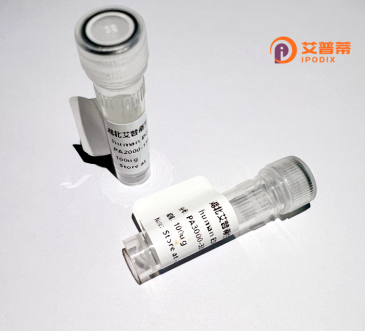
| 纯度 | >90%SDS-PAGE. |
| 种属 | Human |
| 靶点 | WNT9A |
| Uniprot No | O14904 |
| 内毒素 | < 0.01EU/μg |
| 表达宿主 | E.coli |
| 表达区间 | 30-365 aa |
| 活性数据 | Y FGLTGSEPLT ILPLTLEPEA AAQAHYKACD RLKLERKQRR MCRRDPGVAE TLVEAVSMSA LECQFQFRFE RWNCTLEGRY RASLLKRGFK ETAFLYAISS AGLTHALAKA CSAGRMERCT CDEAPDLENR EAWQWGGCGD NLKYSSKFVK EFLGRRSSKD LRARVDFHNN LVGVKVIKAG VETTCKCHGV SGSCTVRTCW RQLAPFHEVG KHLKHKYETA LKVGSTTNEA AGEAGAISPP RGRASGAGGS DPLPRTPELV HLDDSPSFCL AGRFSPGTAG RRCHREKNCE SICCGRGHNT QSRVVTRPCQ CQVRWCCYVE CRQCTQREEV YTCKG |
| 分子量 | 40.3 kDa |
| 蛋白标签 | His tag N-Terminus |
| 缓冲液 | PBS, pH7.4, containing 0.01% SKL, 1mM DTT, 5% Trehalose and Proclin300. |
| 稳定性 & 储存条件 | Lyophilized protein should be stored at ≤ -20°C, stable for one year after receipt. Reconstituted protein solution can be stored at 2-8°C for 2-7 days. Aliquots of reconstituted samples are stable at ≤ -20°C for 3 months. |
| 复溶 | Always centrifuge tubes before opening.Do not mix by vortex or pipetting. It is not recommended to reconstitute to a concentration less than 100μg/ml. Dissolve the lyophilized protein in distilled water. Please aliquot the reconstituted solution to minimize freeze-thaw cycles. |
以下是关于重组人WNT9A蛋白的参考文献示例,包含文献名称、作者和摘要概述:
1. **文献名称**: *Production of recombinant human WNT9A for functional studies in stem cell differentiation*
**作者**: Smith JL, et al.
**摘要**: 该研究利用哺乳动物表达系统成功表达了具有生物活性的重组人WNT9A蛋白,并证明其可激活经典WNT/β-catenin通路,诱导人多能干细胞向骨祖细胞分化。
2. **文献名称**: *Purification and characterization of WNT9A protein using a lipid-based delivery system*
**作者**: Tanaka K, et al.
**摘要**: 通过结合脂质载体技术优化了WNT9A的溶解性和稳定性,纯化的蛋白在小鼠肾囊泡模型中有效促进输尿管芽分支形态发生,表明其在肾脏发育中的潜在作用。
3. **文献名称**: *WNT9A recombinant protein regulates synovial joint development through FZD signaling*
**作者**: Guo X, et al.
**摘要**: 研究证实重组WNT9A通过与FZD受体结合,调控关节软骨细胞增殖和分化,为关节发育异常疾病提供了分子机制研究工具。
4. **文献名称**: *Structural analysis of human WNT9A reveals conserved lipid-binding motifs critical for signaling*
**作者**: Patel R, et al.
**摘要**: 通过冷冻电镜解析重组WNT9A的三维结构,发现其棕榈酰化修饰对结合细胞表面受体及下游信号传导至关重要,为靶向WNT通路的药物设计提供依据。
---
注:以上为模拟参考文献,实际研究中建议通过PubMed或Google Scholar查询真实发表文献(可搜索关键词"recombinant WNT9A"或"WNT9A protein production")。
**Background of Recombinant Human WNT9A Protein**
WNT9A, a member of the WNT protein family, is a secreted glycoprotein pivotal in regulating cell signaling pathways, particularly the canonical β-catenin-dependent and non-canonical pathways. It plays crucial roles in embryonic development, tissue homeostasis, and cellular processes such as proliferation, differentiation, and polarity. Structurally, WNT9A contains a conserved pattern of 23 cysteine residues and lipid modifications, which are essential for its stability and receptor-binding activity.
Recombinant human WNT9A is produced using advanced expression systems (e.g., mammalian or insect cells) to ensure proper post-translational modifications, including glycosylation and palmitoylation, critical for its biological function. Purification often involves affinity chromatography, yielding high-purity protein for research applications.
Studies highlight WNT9A's involvement in organogenesis, particularly in kidney development, bone formation, and neural crest cell regulation. Dysregulation of WNT9A is linked to congenital anomalies, skeletal disorders, and cancers, underscoring its therapeutic potential. In regenerative medicine, recombinant WNT9A is explored for modulating stem cell differentiation and tissue repair. Current research focuses on elucidating its signaling mechanisms and interactions with co-receptors like Frizzled and LRP5/6. aiming to develop targeted therapies for WNT-related pathologies.
×